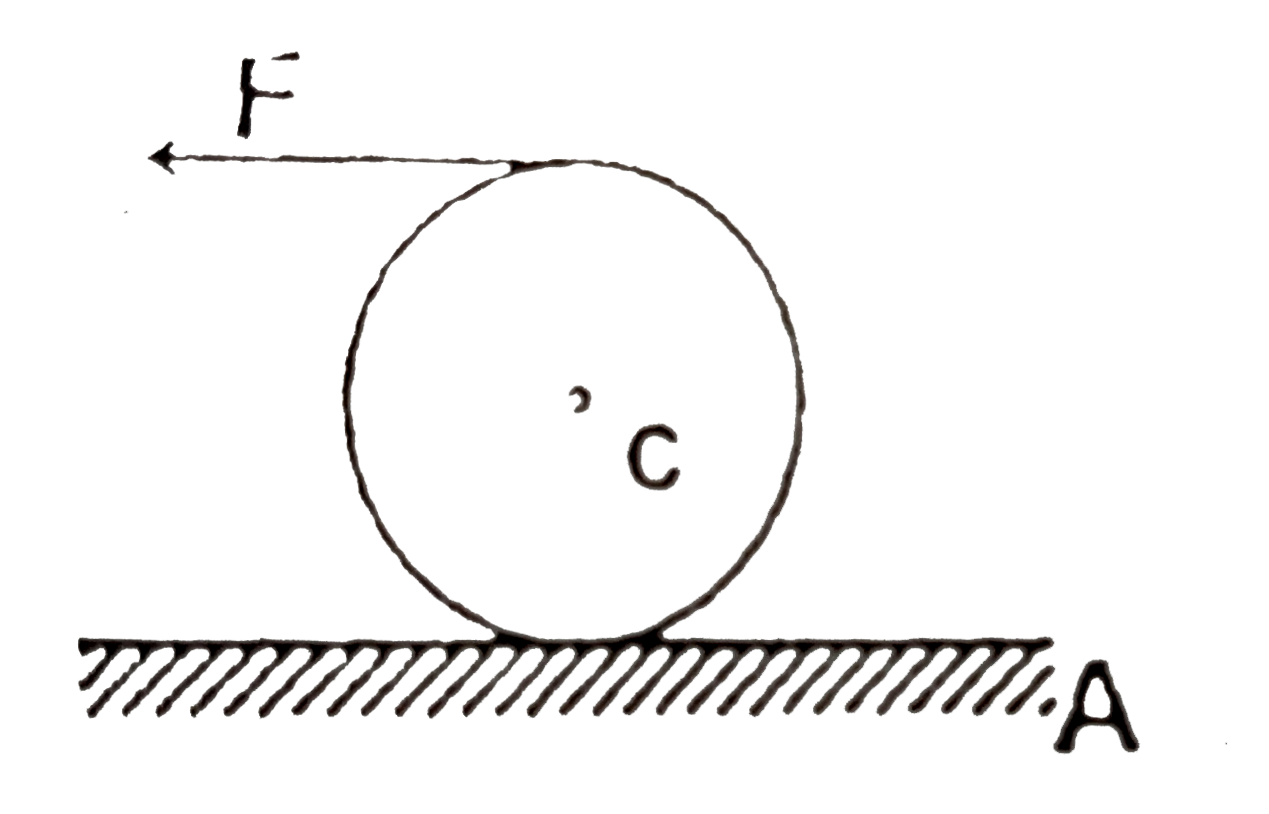A body of mass m is kept on a rough horizontal surface of friction coefficient μ . A force P is applied horizontally , but the body is not moving .Find the net force F exerted by the surface on the body .
To solve the problem step by step, we need to analyze the forces acting on the body that is at rest on a rough horizontal surface.
Step 1: Identify the forces acting on the body
- The weight of the body (W) acting downwards: W=mg
- The normal force (N) acting upwards from the surface.
- The applied force (P) acting horizontally to the right.
- The frictional force (f) acting horizontally to the left, opposing the applied force.
Step 2: Apply Newton's First Law
Since the body is not moving, it is in equilibrium. Therefore, the sum of the forces in both the horizontal and vertical directions must be zero.
Vertical Forces:
- The normal force (N) balances the weight of the body (mg):
N−mg=0⟹N=mg
Horizontal Forces:
- The frictional force (f) balances the applied force (P):
f−P=0⟹f=P
Step 3: Determine the net force exerted by the surface
The net force exerted by the surface on the body is the resultant of the normal force and the frictional force. These two forces are perpendicular to each other.
Using the Pythagorean theorem, the resultant force (F) exerted by the surface can be calculated as:
F=√N2+f2
Substituting the values of N and f:
F=√(mg)2+P2
Conclusion
The net force F exerted by the surface on the body is:
F=√(mg)2+P2
---
- The weight of the body (W) acting downwards: W=mg
- The normal force (N) acting upwards from the surface.
- The applied force (P) acting horizontally to the right.
- The frictional force (f) acting horizontally to the left, opposing the applied force.
Since the body is not moving, it is in equilibrium. Therefore, the sum of the forces in both the horizontal and vertical directions must be zero.
- The normal force (N) balances the weight of the body (mg):
N−mg=0⟹N=mg
- The frictional force (f) balances the applied force (P):
f−P=0⟹f=P
The net force exerted by the surface on the body is the resultant of the normal force and the frictional force. These two forces are perpendicular to each other.
F=√N2+f2
F=√(mg)2+P2
The net force F exerted by the surface on the body is:
F=√(mg)2+P2
Topper's Solved these Questions
- BOOK - CENGAGE PHYSICS ENGLISHCHAPTER - NEWTON'S LAWS OF MOTION 2EXERCISE - Exercise 7.216videos
NEWTON'S LAWS OF MOTION 2
- BOOK - CENGAGE PHYSICS ENGLISHCHAPTER - NEWTON'S LAWS OF MOTION 2EXERCISE - Exercise 7.327videos
NEWTON'S LAWS OF MOTION 2
- BOOK - CENGAGE PHYSICS ENGLISHCHAPTER - NEWTON'S LAWS OF MOTION 2EXERCISE - Solved Examples12videos
NEWTON'S LAWS OF MOTION 2
- BOOK - CENGAGE PHYSICS ENGLISHCHAPTER - NEWTON'S LAWS OF MOTION 1EXERCISE - Integer5videos
NEWTON'S LAWS OF MOTION 1
- BOOK - CENGAGE PHYSICS ENGLISHCHAPTER - PROPERTIES OF SOLIDS AND FLUIDSEXERCISE - INTEGER_TYPE2videos
PROPERTIES OF SOLIDS AND FLUIDS
Similar Questions
A body of mass M is kept on a rough horizontal surface (friction coefficient =μ). A person is trying to pull the body by applying a horizontal force but the body is not moving. The force by the horizontal surface on the surface of the body is F, where
View SolutionA block of mass m is kept on a horizontal table. If the static friction coefficient is μ., find the frictional force acting on the block.
View SolutionA block of mass m is moving on a rough horizontal surface. μ is the coefficient of kinetic friction between the block and the surface. What is the net force exerted by the surface on the block?
View SolutionA block of mass 4 kg is kept on a rough horizontal surface. The coefficient of static friction is 0.8. If a forace of 19 N is applied on the block parallel to the floor, then the force of friction between the block and floor is
View SolutionA body of mass 2kg is kept on a rough horizontal surface as shown in the figure. If coefficient of friction is 0.5, find the work done by frictional force in the interval t=0 to t=5sec
 View Solution
View SolutionA block of mass 10kg is placed on a rough horizontal surface having coefficient of friction μ=0.5 . If a horizontal force of 100N is acting on it, then acceleration of the will be.
View SolutionA block of mass 10kg is placed on a rough horizontal surface having coefficient of friction μ=0.5 . If a horizontal force of 100N is acting on it, then acceleration of the will be.
View SolutionA block of mass 1 kg in kept on a rough horizontal surface with μs=0.1 . A force of 0.5 N is applied as shown in the figure. What is the frictional force applied by ground on the block?
 View Solution
View SolutionA massless string is wrapped around a hollow cylinder having mass m and radius r. The cylinder is kept on a rough horizontal surface (coefficient of friction is μ). A constant force F is applied as shown in the figure. In case of pure rolling, the friction force acting on the bottom most point of the cylinder is
 View Solution
View SolutionA body of mass 2kg is placed on a horizontal surface having kinetic friction 0.4 and static friction 0.5 . If the force applied on the body is 2.5N , then the frictional force acting on the body will be
View Solution

